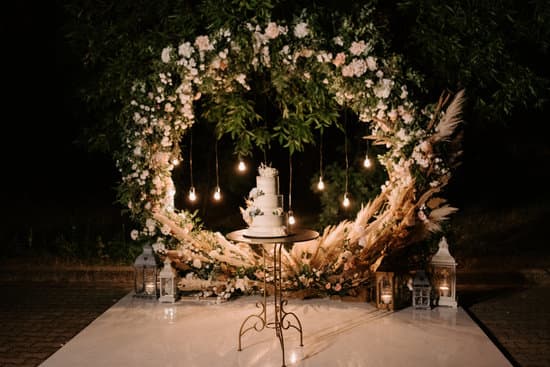What is the grand march at a wedding? The grand march, also known as the wedding march, holds significant cultural and historical roots in many different societies around the world.
This traditional wedding procession has been a staple in numerous cultures for centuries, symbolizing the formal introduction of the newlyweds to their guests. In this article, we will delve into the history and significance of the grand march at weddings, exploring its order of events, music and dance style, attire and decor, modern variations, cultural influences, and tips for a flawless execution.
The grand march at a wedding is more than just a procession; it holds deep cultural significance and often signifies the transition of two individuals into a unified partnership. Understanding the origins and importance of this tradition can provide insight into the deeper meaning behind a seemingly simple act.
Throughout history, various cultures have incorporated their own unique customs and rituals into their grand marches, making it an integral part of their wedding celebrations. From traditional music and dance styles to special attire and decorations, every aspect of the grand march holds symbolic meaning and reflects the values and traditions of the community in which it takes place.
In the following sections, we will unravel the rich history behind this timeless tradition and explore how it has evolved to adapt to modern times. We will also provide practical tips for couples and wedding planners to ensure that their grand march is executed flawlessly on their special day.
Whether you are interested in learning about different cultural influences or seeking inspiration for your own wedding ceremony, this article aims to be a comprehensive guide to understanding and appreciating the grand march at a wedding.
The Tradition of the Grand March
The grand march at a wedding is a beloved tradition with deep cultural and historical significance. This ceremonial procession has its roots in Europe, particularly in countries like Germany, Poland, and Scandinavia. It was originally a way for the bridal party to enter the reception hall and kick off the festivities with a joyful and celebratory entrance.
The grand march is often accompanied by lively music, such as polkas or other folk dances, which adds to the festive atmosphere. In some cultures, certain steps or choreographed movements are performed during the march, adding an element of entertainment for the guests.
In addition to its role as a fun and festive tradition, the grand march also serves as a symbolic gesture of unity and community. As the newlyweds lead their bridal party into the reception venue, it represents their transition into married life surrounded by their loved ones. The grand march is not only a celebration of the couple’s love but also a reflection of their cultural heritage and familial traditions.
- Origins of the grand march
- Cultural significance
- Traditional music and dance styles
The Order of Events
The grand march, also known as the wedding march or bridal march, is a traditional procession that occurs at some weddings. This section will break down the sequence of events that make up this unique and culturally significant tradition.
Entrance of the Wedding Party
The grand march typically begins with the entrance of the wedding party. This includes the parents of the couple, followed by bridesmaids and groomsmen, often paired together as they make their way into the reception area. The order of entrance can vary depending on cultural or personal preferences, but it is customary for the maid/matron of honor and best man to enter last before the couple.
Introduction of the Couple
After the entire wedding party has made their entrance, it is time for the guests to eagerly await the arrival of the newly married couple. The DJ or emcee will announce their names as they make their grand entrance into the reception area. This moment marks a celebratory transition from their wedding ceremony to their reception.
Formation and Dance
Once all members of the wedding party are in place, a dance often follows. The grand march usually consists of a choreographed dance involving intricate steps or formations that may incorporate traditional folk dances, waltzes, polkas, or other regional styles depending on cultural influences.
This sequence serves not only as a formal introduction to key members of family and friends but also sets an energetic tone for celebration at weddings. It is truly a beautiful and heartwarming tradition that brings everyone together to celebrate love and new beginnings.
Music and Dance
The grand march at a wedding is a significant and cherished tradition that often involves music and dance. The music and dance style associated with the grand march can vary depending on cultural influences and personal preferences of the couple. Here is a breakdown of the traditional music and dance styles that are commonly associated with the grand march:
- Traditional Music: The grand march typically begins with a lively and celebratory tune that sets the tone for the entrance of the wedding party. Bagpipes, fiddles, or other traditional instruments may be used to accompany the procession. The music often builds in intensity as the couple makes their grand entrance, creating an atmosphere of joy and excitement.
- Dance Style: The dance accompanying the grand march is usually a simple two-step or promenade, allowing everyone to easily join in and follow along. As the wedding party enters, they may perform choreographed movements, adding an element of coordination and spectacle to the procession. Guests are often encouraged to join in as well, creating a sense of unity and celebration.
- Cultural Variations: Different cultures have their own unique music and dance styles associated with the grand march. For example, in some Scandinavian weddings, couples may perform a traditional polonaise or waltz during their grand entrance. Other cultures may incorporate specific ceremonial dances or songs that hold deep cultural significance.
The music and dance elements of the grand march add a festive and joyous ambiance to a wedding celebration. Couples can choose to embrace traditional tunes and movements or put their own modern twist on this cherished tradition.
Attire and Decor
The grand march at a wedding is not just a procession of the wedding party, but it is also an opportunity for everyone to showcase their beautiful attire and participate in a joyful celebration. The tradition of the grand march dates back to the 19th century when it was commonly practiced in European countries such as Germany and Poland.
The grand march was originally known as “Jenny Pluck Pears” in Scotland, where it involved a mixture of singing, dancing, and elaborate costumes.
One of the most charming aspects of the grand march is the traditional attire worn by the participants. In many cultures, the couple and their wedding party dress in formal attire or cultural clothing that holds significant meaning. This could mean donning traditional wedding dresses and suits or wearing garments that represent the couple’s heritage. For example, in some African weddings, participants wear vibrant and colorful clothing that reflects their cultural identity.
Decorations play a crucial role in setting the stage for a grand march. The venue where the grand march takes place is often adorned with flowers, ribbons, and other decorative elements to create a festive atmosphere. Many couples opt for personalized decor elements that reflect their personalities and love story. These may include custom banners, lighting effects, or themed decorations that tie into their overall wedding theme.
| Aspect | Description |
|---|---|
| Attire | Participants wear formal or cultural clothing with significant meaning |
| Decorations | Venue adorned with flowers, ribbons, and personalized decor elements |
Modern Twists
Personalized Entrance
In modern weddings, couples are adding their own unique touches to the grand march. Instead of sticking to traditional entrances, couples are personalizing their grand march by incorporating their hobbies, interests, or shared experiences into their entrance. For example, some couples may choose to enter with a dance routine they have choreographed themselves, while others may opt for a fun and quirky entrance that reflects their personalities.
Themed Grand March
Another modern twist on the grand march is the incorporation of themed entrances. Couples are embracing creativity by choosing a specific theme for their grand march, such as a masquerade ball, a vintage Hollywood glamour theme, or a fairytale-inspired entrance. This allows the couple and their wedding party to dress up according to the chosen theme and adds an extra element of fun and excitement to the proceedings.
Tech-Savvy Additions
With the rise of technology, some couples are incorporating tech-savvy elements into their grand marches. This can include using special lighting effects, holograms, or even drone footage to capture unique perspectives of the grand march. Additionally, couples may choose to create custom playlists or have live music performances during the grand march to add a modern touch to the event.
These modern twists and personalizations allow couples to put their own stamp on this age-old tradition while also creating memorable moments for themselves and their guests during the grand march at their wedding.
Cultural Influences
The grand march at a wedding is not only a tradition in one culture but can be found in various cultures around the world, each with its unique customs and rituals. In many European countries, the grand march is known as the “bridal dance” and involves the newlyweds leading the procession while holding hands, followed by their parents and then the rest of the wedding party.
This symbolizes unity and solidarity, emphasizing the support of family and friends as the couple begins their married life together.
In some African cultures, such as in Nigeria and Ghana, the grand march is a vibrant and lively celebration that includes traditional music, colorful costumes, and energetic dance routines. It is an opportunity for guests to showcase their best dance moves and for the couple to enjoy a festive entrance into their reception venue. The grand march often represents the community’s involvement in celebrating the union of two individuals and their families.
In Filipino weddings, the grand march is called “the bridal parade” or “the wedding party walk.” This tradition typically involves all members of the entourage walking down an aisle-like pathway, usually while an upbeat song plays in the background. The atmosphere is filled with joyous celebration as all attendees join in dancing before taking their seats for dinner and other festivities.
Overall, these examples demonstrate how diverse cultures incorporate their own unique elements into the grand march at weddings. It showcases not only different customs but also emphasizes joy, unity, and celebration across various traditions.
| Cultural Influence | Description |
|---|---|
| European | In many European countries, this is known as “bridal dance” symbolizing unity and solidarity |
| African | A vibrant and lively celebration with traditional music, colorful costumes, and energetic dance routines |
| Filipino | Called “the bridal parade” or “the wedding party walk,” a joyous celebration with upbeat music playing in background. |
Tips for the Perfect Grand March
In conclusion, the grand march at a wedding is a cherished tradition with deep cultural roots and historical significance. From its origins in Europe to its modern variations, the grand march has remained an integral part of weddings across different cultures. The order of events, music and dance style, attire and decorations associated with the grand march all contribute to the unique charm and celebratory atmosphere of this tradition.
For couples and wedding planners looking to execute a flawless grand march at a wedding, there are several practical tips to consider. First and foremost, it’s important to communicate with the wedding party and make sure everyone understands their role in the grand march.
Rehearsing the sequence of events can help ensure a smooth and coordinated entrance for the couple. Additionally, choosing appropriate music that captures the celebratory spirit of the grand march is essential for creating an unforgettable experience for everyone involved.
Incorporating personal touches and modern twists into the grand march can also add another layer of significance to this tradition. Whether it’s showcasing cultural influences or adding unique elements that reflect the couple’s personalities, these personalized details can make the grand march even more memorable. Ultimately, with careful planning and attention to detail, couples can create a perfect grand march that sets the tone for a joyous celebration of their union.
Frequently Asked Questions
What Is a Grand March for a Wedding?
A Grand March for a wedding is a traditional entrance where the newlywed couple and their bridal party enter the reception venue in a choreographed manner. It is often accompanied by music and cheers from the guests.
What Does the Grand March Symbolize?
The Grand March symbolizes the celebration of the newlywed couple’s union and their official entrance into the reception as a married couple. It also represents the support and well-wishes of their family and friends as they begin this new chapter in their lives.
What Is the Meaning of Grand March?
The meaning of a Grand March goes beyond just being an entrance; it signifies unity, joy, and togetherness. It is a way for the couple to showcase their love and commitment, while also giving their loved ones an opportunity to join in on the festivities and show their support.

I have been involved in marriages for over 20 years helping couples and singles understand more about them.





